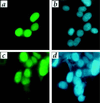Menin, the product of the MEN1 gene, is a nuclear protein
- PMID: 9465067
- PMCID: PMC19125
- DOI: 10.1073/pnas.95.4.1630
Menin, the product of the MEN1 gene, is a nuclear protein
Abstract
The MEN1 gene, mutations in which are responsible for multiple endocrine neoplasia type 1 (MEN1), encodes a 610-amino acid protein, denoted menin. The amino acid sequence of this putative tumor suppressor offers no clue to the function or subcellular location of the protein. We report herein, based on immunofluorescence, Western blotting of subcellular fractions, and epitope tagging with enhanced green fluorescent protein, that menin is located primarily in the nucleus. Enhanced green fluorescent protein-tagged menin deletion constructs identify at least two independent nuclear localization signals (NLS), both located in the C-terminal fourth of the protein. Among the 68 known independent disease-associated mutations, none of the 22 missense and 3 in-frame deletions affect either of the putative NLS sequences. However, if expressed, none of the truncated menin proteins resulting from the 43 known frameshift/nonsense mutations would retain both the NLSs. The precise role(s) of menin in the nucleus remain to be understood.
Figures



References
-
- Metz D C, Jensen R T, Bale A E, Skarulis M C, Eastman R C, Nieman L, Norton J A, Friedman E, Larsson C, Amorossi A, et al. In: The Parathyroids. Bilezekian J P, Levine M A, Marcus R, editors. New York: Raven; 1994. pp. 591–646.
-
- Chandrasekharappa S C, Guru S C, Manickam P, Olufemi S E, Collins F S, Emmert-Buck M R, Debelenko L V, Zhuang Z, Lubensky I A, Liotta L A, et al. Science. 1997;276:404–407. - PubMed
-
- Agarwal S K, Kester M B, Debelenko L V, Heppner C, Emmert-Buck M R, Skarulis M C, Doppman J L, Kim Y S, Lubensky I A, Zhuang Z, et al. Hum Mol Genet. 1997;6:1169–1175. - PubMed
-
- The European Consortium on MEN1. Hum Mol Genet. 1997;6:1177–1183. - PubMed
-
- Heppner C, Kester M B, Agarwal S K, Debelenko L V, Emmert-Buck M R, Guru S C, Manickam P, Olufemi S E, Skarulis M C, Doppman J L, et al. Nat Genet. 1997;16:375–378. - PubMed
MeSH terms
Substances
LinkOut - more resources
Full Text Sources
Molecular Biology Databases

